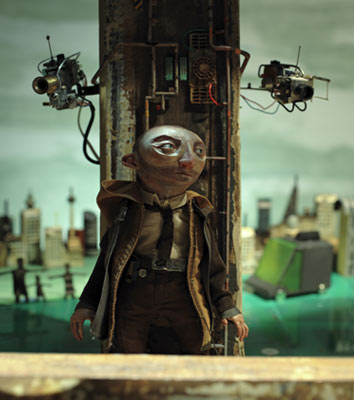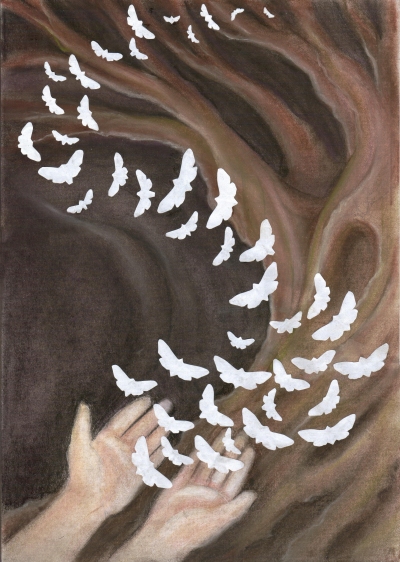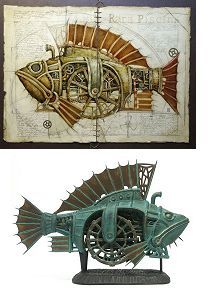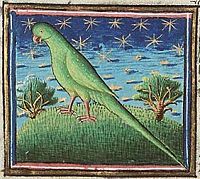A fine drawing by Alexandre Kha (Mister Kha on Flickr), titled Korea : a shadow puppet.

Chris Sickels at Red Nose Studio makes real figures and scenarios that are then photographed to produce cool 3D illustrations for papers, magazines and books. The 3D illustration above is his cover for Cory Doctorow’s story The Things That Make Me Weak and Strange Get Engineered Away. Before seeing this I had thought of 3D illustration as more a virtual rendering process. In this real form it is closely, and interestingly, allied to my work making puppets and props. I recently had a picture of my 3D fail whale published as an illustration in the Japanese computer magazine WEB+DB PRESS. I suppose that is fairly close – the only difference is in your intention when you start making an object?
(via @LolaLulu)
Actually, my favourite Sendak picture book is In the Night Kitchen. I love the illustration, the cityscape made from kitchen packets and utensils, the dreamlike whimsy of it, and Mickey’s confidence. Above all, I like the part where he models the dough into a plane:

What better way to describe how you go about the creative process? I was delighted to find this lovely video animation of the book, adapted and directed by Gene Dietch, complete with jaunty music:
Happy New Year, blog friends. A new year and my 300th post!
Last night I dreamed vividly (and I mean vivid physically!) of giving birth – one of those oops-I-need-to-push, and-I’m-in-the-supermarket-and, oh-my-goodness-here-it-is! births, and then a tiny crumpled gorgeous creature cupped in my hands! (maybe because I had seen the tiny animals on fingers photos?)! You will have to take my word for it that it was a good dream, though, and surely its auspicious to dream of giving birth on a new year’s day, don’t you think?
These are the draft drawings I did for the poster for The Moth Tree. I’m particularly fond of the one with the little girl in it.
I used some chalky pastels to do this, and I always forget what lovely effects they give and how much pleasure I get from using them. I should really draw more often, just for pleasure.

A while ago I discovered a lovely sculpture in the ANU, Winged Harvest by Fiona Foley, which has silver bogong moths. I didn’t give them a thought when I was doing the poster, but I really think there must have been some subconscious connection going on here.
(photo credit: Tim Raupach: Cutflat)
Over the last while I have been involved in designing and making the set, costumes and puppets for Canberra Youth Theatre‘s production, The Moth Tree: An Awesome Adventure.
The Moth Tree is a quest story set in a distant place, in a quiet part
of the world, where the ancient and beautiful Algoma City lies. Since
the very beginning of time the city has been protected by moths that
grow on an enchanted tree. Until now the city has been a haven of
harmony and a place of gentle joy. However, a band of villains have
hatched a wicked plot to bring the city to its knees. All that stands
against the coming darkness are a ragged pair of unlikely young
heroes…
The play has been developed in a collaborative process involving the group of 8 to 12 year olds, the director, Tim Hanson, and the writer, Shiereen Magsalin, workshopping and developing characters and plot lines. The intention has been to offer the kids the experience of creating and presenting theatre, with a crew of professionals. We open tomorrow night! If you are in Canberra and have kids, why not take them along to some live theatre?
Following on from yesterday’s post about the puppet-based theatre adaptation of Shaun Tan’s picture book, The Red Tree, today I discovered that Spare Parts Puppet Theatre’s adaptation of Shaun’s new book, The Arrival, had just finished it’s season in Perth. The production, which The Australian gives a rave review, uses digital animation, puppetry and acting, and is visual theatre:
‘The absence of words not only makes the story perfect for puppetry but emphasizes the isolation that is experienced by many people arriving in a new place.’
Although The Arrival book doesn’t come out until October, there is an online preview, in which you can see some of the pages, and read Shaun’s detailed description. It looks wonderful – a 128 page book of illustrations without words, a
silent graphic novel, arranged and presented rather like a photo album, which can be interpreted rather like a silent film. ‘Through a series of connecting images, it tells the story of an anonymous migrant leaving some unfortunate
circumstances in his home country, crossing an ocean to a strange new city, and learning how to live here.’
The Lost Thing, another Tan book that was made into puppet theatre by Jigsaw Theatre Company here in Canberra a few years ago, and for which I made puppets, has been touring since, and is due to have a season in Melbourne this November at the Arts Centre.
I also came across some photos at Flickr of a Shaun Tan mural at the Subiaco Library in Perth.
Update:
Talking Squid’s review by Russell B. Farr
Links updated 2015
 Vladimir Gvozdariki is a Russian artist who makes whimsical figures, animations and images. Some are pleasing in their simplicity, but I particularly like his complicated drawings of mechanized animal structures. They are in numerous places in his galleries, like here, here and here and here. I also like how some, like this fish, have made the transition from drawing to sculpture. I could imagine them being used theatrically, and some aspects -the whimsy and the technical details – remind me of some of Shaun Tan‘s creatures in The Lost Thing.
Vladimir Gvozdariki is a Russian artist who makes whimsical figures, animations and images. Some are pleasing in their simplicity, but I particularly like his complicated drawings of mechanized animal structures. They are in numerous places in his galleries, like here, here and here and here. I also like how some, like this fish, have made the transition from drawing to sculpture. I could imagine them being used theatrically, and some aspects -the whimsy and the technical details – remind me of some of Shaun Tan‘s creatures in The Lost Thing.
I also like Gvozdariki’s interest in snails and miniature worlds. How would you like to live here?
(via the wonderful BibliOdessy)
The following illustration is by Tibor Gergely from the Little Golden Book ‘Houses’ by Elsa Jane Werner. I’m posting it as a comparison to the one by Richard Scarry in another Little Golden Book, ‘Cars and Trucks’, over at Wee Wonderfuls. There is an interesting discussion there about how in updates of the book that particular illustration has been changed to accommodate a more feminist attitude to gender roles. This one obviously belongs firmly in the earlier era, and I wonder if it was changed in a similar way later on?

I don’t have an exact date for this book – its one of a set of four books that together make up a ‘Little Golden Book Library’ that I bought in about 1983, and the dates given collectively are 1948 through 1969.
I was interested to see in an online bio of Tibor Gergely that as a young man he worked for two years in a Vienna marionette theatre as a puppet designer and stage decorator :-).
 This green parrot is one of the many lovely animal illustrations catalogued on The Medieval Bestiary: Animals in the Middle Ages. Its a nicely organized site, with alphabetical ordering and cross-referencing, and information about the beasts from manuscripts. For each beast there is usually a gallery of different images from different sources.
This green parrot is one of the many lovely animal illustrations catalogued on The Medieval Bestiary: Animals in the Middle Ages. Its a nicely organized site, with alphabetical ordering and cross-referencing, and information about the beasts from manuscripts. For each beast there is usually a gallery of different images from different sources.
Did you know, for example, that a dragon’s strength is found in its tail, not in its teeth? And that ‘it is the enemy of the elephant, and hides near paths where elephants walk so that it can catch them with its tail and kill them by suffocation’? Or that ‘it is because of the threat of the dragon that elephants give birth in the water’?